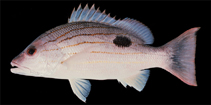| Family: |
Lutjanidae (Snappers), subfamily: Lutjaninae |
| Max. size: |
22.6 cm SL (male/unsexed) |
| Environment: |
reef-associated; freshwater; brackish; marine; depth range 5 - 50 m |
| Distribution: |
Indian Ocean: northern continental margin of the Indian Ocean including western Thailand, Myanmar, Andaman Islands, Sri Lanka, India, Gulf of Oman and Arabian Gulf. Western Indian Ocean distribution of L. russellii mentioned in Allen & Talbot, 1985 (Ref. 469) is provisionally referred to as L. indicus; population needs to be reassessed.. |
| Diagnosis: |
Dorsal spines (total): 10-10; Dorsal soft rays (total): 13-14; Anal spines: 3-3; Anal soft rays: 8-8. This species is distinguished by the following set of characters: D X,13-14 (usually 14); total gill rakers 12-14; body depth 2.5-2.9 in SL; eye 4.2-4.6 in HL; interorbital 5.9-7.0 in HL; the scale rows above the lateral line rise obliquely toward dorsal profile; predorsal scales extending forward nearly to level of rear part of orbit; weakly developed preopercular notch and interopercular knob; upper surface of tongue with central patch of fine granular teeth; vomer with diamond-shaped to narrowly crescent-shaped patch of granular teeth with medial posterior extension; truncate caudal fin; in life it is overall pale grey, grading to silvery white on cheek, opercle, and lower side of body with series of seven dark brown to yellow stripes on posterior head and side, prominent black spot, about 1.2-1.5 size of eye, on posterior back below base of first 6-7 soft dorsal rays, its lowermost part occupying about one scale row below lateral line (Ref. 93093). |
| Biology: |
This species was observed in coral-reef habitat; generally encountered solitary or in small groups in about 5-15 m depth. It is also taken by trawlers in deeper water (to at least 50 m) and usually appears in fish markets. Few information on juvenile habitat, but suspected to be similar to L. russellii where young are found in brackish mangrove estuaries and lower reaches of freshwater streams (Ref. 93093). |
| IUCN Red List Status: |
Least Concern (LC); Date assessed: 28 June 2018 Ref. (130435)
|
| Threat to humans: |
harmless |
| Country info: |
|
Source and more info: www.fishbase.org. For personal, classroom, and other internal use only. Not for publication.

